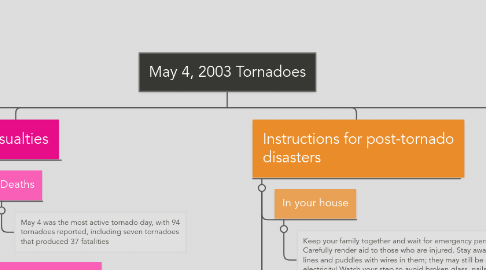
1. How did the disaster start?
1.1. A warm breeze
1.1.1. Warm humid air from the Gulf of Mexico crept to the North-towards Kansas and Missouri
1.2. Cooler, dry air
1.2.1. Cooler, dry air flowing Eastward from the deserts collided with the cooler air from the Gulf of Mexico. The meeting place was around the Kansas and Missouri states.
1.3. Low Pressure causes massive tornadoes
1.3.1. One of the factors that produce deadly storms is the collision of warm, humid air from the Gulf of Mexico and drier air flowing eastward from the U.S. Southwest deserts. When this happens warm air rises above the dry air, creating unstable, thunderstorm-spawning conditions.
2. Spawing of tornadoes
2.1. Tornadoes
2.1.1. A large tornado and several smaller tornadoes hit the Kansas City metro area late Sunday afternoon, destroying dozens of homes.
2.1.2. The severity of the tornadoes were such that even well-anchored frame houses were torn apart. It did not make much difference whether the house was new or old, mobile or modular.
2.2. Other weather
2.2.1. Hail as big as baseballs pitched down onto some areas, destroying cars and windows.
2.2.2. Live images from news helicopters showed significant damage to homes. Large trees were toppled and roofs were blown off.
2.3. Aftermath
2.3.1. Kansas to Tennessee were without power late Monday. Many of them faced the formidable task of rebuilding homes wiped out in the storms.
3. Casualties
3.1. Deaths
3.1.1. May 4 was the most active tornado day, with 94 tornadoes reported, including seven tornadoes that produced 37 fatalities
3.2. Types of tornadoes
3.2.1. One of the May 4 tornadoes, the one that struck Franklin, Kansas, was a high-end F4. It had winds that approached 260 mph. Winds that high can transform a car into an airborne missile
3.3. Fujita Tornado Scale
3.3.1. The Fujita Tornado scale is a system in which we categorize tornadoes. The higher the category, the more deadly it is.
3.3.2. Having three F3s and an F4 on a single day in Southwest Missouri and Southeast Kansas, which is what happened on May 4, is an event that might happen once in a 100 years, Davis said.
4. Instructions for post-tornado disasters
4.1. In your house
4.1.1. Keep your family together and wait for emergency personnel to arrive. Carefully render aid to those who are injured. Stay away from power lines and puddles with wires in them; they may still be carrying electricity! Watch your step to avoid broken glass, nails, and other sharp objects.
4.2. In a car
4.2.1. If the tornado is visible, far away, and the traffic is light, you may be able to drive out of its path by moving at right angles to the tornado. Seek shelter in a sturdy building, or underground if possible. If you are caught by extreme winds or flying debris, park the car as quickly and safely as possible -- out of the traffic lanes. Stay in the car with the seat belt on. Put your head down below the windows; cover your head with your hands and a blanket, coat, or other cushion if possible.
4.3. Average time for tornado warning
4.3.1. The average time for tornadoes warnings is approximately 13 minutes, plenty of time to get prepared
5. What can be done to lower the damage?
5.1. Garage Doors
5.1.1. If wind enters a garage it can cause dangerous and expensive structural damage to the home. A garage door can be reinforced by adding braces across the back of the door and by strengthening the glider wheel tracks.
5.2. Trees
5.2.1. The surest way to prevent storm damage on a home from falling trees, is to locate trees far enough away from your house that they can?t fall on it. The distance between your house and any nearby tree should be greater than the height the tree will reach when it is fully grown.
5.3. Outdoor sheds/appliances
5.3.1. All outdoor sheds and appliances should be bolted down to the ground to prevent them to become a missile in the tornado disaster
6. Controversy
6.1. Conflicting Advice
6.1.1. There are still arguments today about whether or not to stay put or try and outrun a 2.6 mile wide tornado.
6.1.2. The NOAA recommends staying in secure shelter when tornadoes strike.
6.2. Your choice
6.2.1. It depends on your confidence in driving and fast you can escape the tornadoes. Taking a risk may save your life.
6.3. Upgrades
6.3.1. Unless you were hiding in a cave…there was absolutely no excuse for you to not know that tornadoes were heading your way.
6.3.2. Always be prepared.
